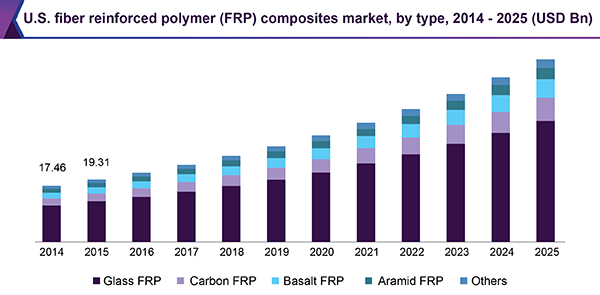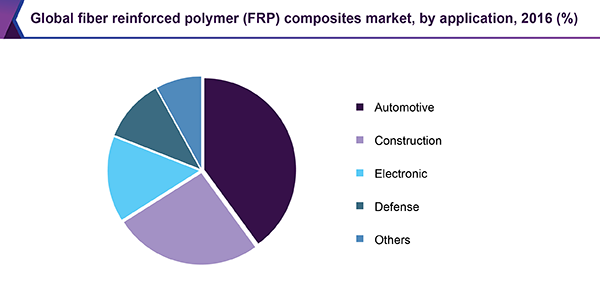- Home
- »
- Specialty Polymers
- »
-
Fiber Reinforced Polymer Composites Market Report, 2025GVR Report cover
![Fiber Reinforced Polymer (FRP) Composites Market Report]()
Fiber Reinforced Polymer (FRP) Composites Market Analysis By Fiber Type (Glass, Carbon, Basalt, Aramid), By Application (Automotive, Construction, Electronic, Defense), By Region, And Segment Forecasts, 2018 - 2025
- Report ID: GVR-2-68038-006-4
- Number of Pages: 95
- Format: Electronic (PDF)
- Historical Range: 2014 - 2015
- Industry: Specialty & Chemicals
Industry Insights
The global fiber reinforced polymer (FRP) composites market size was worth USD 114.13 billion in 2016. FRP composites offer several features such as ease of shaping, strength, fatigue resistance, high stiffness, and low density over steel and other nonferrous metals. The growing demand for corrosion-free concrete reinforcing materials in various end-use applications is expected to boost the market over the forecast period.
The composites are becoming a popular alternative to various ferrous and nonferrous metals. Composites are manufactured by combining plastic polymer resin and reinforcing fibers. The end product retains unique properties such as strength & stiffness of the raw materials used, resulting in enhanced overall performance of the product.

The U.S. market was valued at USD 21.38 billion in 2016 and is predicted to ascend at a CAGR of 11.3% from 2017 to 2025. Major companies in the market are collaborating with various research agencies for exploring bio-based FRP in which either the reinforcement fibers or polymer matrix, or both are obtained from different renewable resources.
The global players present in the industry are investing in the development of new and innovative techniques for manufacturing cost-effective composites. Earlier Europe was a major producer of the product, however, over the last decade, there has been a clear shift toward the Americas and Asia, especially in India, China, Brazil, and the U.S.
Fiber Type Insights
Based on fiber types, the industry has been segmented into glass, carbon, basalt, and aramid FRP composites. Glass fiber reinforced polymer (GFRP) composites, in terms of revenue, dominated the overall market with over 65% share in 2016. GFRP contains glass fibers within the polymer matrix and is popular for several reasons, for instance, it can be easily drawn into high-strength fibers from the molten state and be economically fabricated using different composite-manufacturing techniques. In addition, glass fiber possesses a chemical inertness, when coupled with the plastics, which is very useful in a variety of corrosive environments.
However, the product also comes with certain limitations, such as in spite of high flexibility and strength, it is not very stiff. In addition, it does not display the rigidity that is necessary for certain applications such as bridges and airplanes. GFRP is commonly used for reinforcing fibers for polymeric matrix composites. Moreover, it is least expensive and is widely used in the fiber reinforced plastic industry.
Carbon fiber reinforced polymer (CFRP) composite is lightweight FRP containing carbon fibers. CFRP also provides other beneficial mechanical properties such as low density, strength, and modulus of elasticity over other FRP composites. However, the products also have some disadvantages such as high cost and conductivity.
Carbon is not used in every application due to its high cost. The current market conditions (demand & supply) and rising demand for commercial grade carbon fibers are resulting in price fluctuations of the product dramatically. Depending on the applications, conductivity can be considered both an advantage and a disadvantage for carbon fiber. Many applications prefer using glass over carbon fibers owing to better conductivity. For instance, in the utility industry, products such as ladders require the use of glass fibers. If the glass fiber ladder rails come in contact with the power line the chances of electrocution are much lower in comparison to CRRP.
Application Insights
In terms of revenue, automotive application dominated the overall industry in 2016 with over 40% of the share. FRP composites are mainly used in the automotive industry owing to several advantages such as low weight & cost and enhanced mechanical properties such as strength stiffness, flexibility, & density, and improved surface finish of molded parts.
Glass and carbon fibers are most commonly preferred for the manufacturing of automobiles & their parts. On the basis of performance, reinforced-plastic composites cost more than steel. However, the properties offered by composites are the key reason for their increased preference in the automotive industry.

FRP composites are largely preferred in the construction industry owing to properties such as strength, corrosion resistance, and high durability. The products are preferred for the regeneration of constructed infrastructure such as pipelines, buildings, and bridges. The products are also used for the rehabilitation of concrete structures owing to their low life-cycle costs, tailorable performance characteristics, and ease of application. The various advantageous characteristics of the product and the success of structural rehabilitation measures in the construction industry are expected to boost the market over the forecast period.
Regional Insights
North America and Europe were the major markets for the product in 2016. The regions together accounted for around 60% of the total industry share. North America represents an important economic zone for the industry with the presence of major players and significant growth in the end-user industries. Currently, the deterioration of highways in North America is burning a hole in the pockets of the regional governments due to which the authorities are taking into consideration the usage of suitable construction materials.
This is resulting in the rising use of FRP construction materials in the region as they are considered ideal for the restoration of degraded concrete infrastructure. These composites enhance the performance and strength of the infrastructure and are suitable under harsh environmental conditions.
The Europe industry is growing at a steady rate. The growth of the industry in the overall region is mainly due to the rising demand in the construction and transport application sectors. However, the situation differs from country to country in the region. For instance, the Eastern European countries and Germany are experiencing an above-average growth rate. Whereas, some of the countries in Southern Europe are experiencing a downturn.
The Asia Pacific is expected to be the fastest-growing market over the forecast period. FRP market in India and China is experiencing an above-average growth owing to the rising construction and automotive industries in the region. The growing demand for the product in various end-use applications is expected to boost the market over the forecast period in the region.
Competitive Insights
The industry is highly competitive in nature with the presence of several global market players. The global players are investing in the research & development activities for innovating and producing new reinforced polymers to gain a competitive edge. Some of the global players operating in the industry include American Fiberglass Rebar; American Grating, LLC; Engineered Composites Ltd; B&B FRP Manufacturing INC.; TUF-BAR; FRP Composites Inc.; Ten Cate NV; Zoltek Companies, Inc.; Hyosung Corporation; Mitsubishi Rayon Co., Ltd.; SGL Group; and DowAksa.
Recent Development
- In March 2023, SGL Carbon introduced the new SIGRAFIL® C T50-4.9/235 carbon fiber to expand its material portfolio. The fiber successfully addresses the high strength and high elongation requirements for pressure vessels and other applications.
Report Scope
Attribute
Details
Base year for estimation
2016
Actual estimates/Historical data
2014 - 2015
Forecast period
2017 - 2025
Market representation
Volume in Kilotons, Revenue in USD million and CAGR from 2017 to 2025
Regional scope
North America, Europe, Asia Pacific, Central & South America, Middle East & Africa
Country scope
U.S., U.K., Germany, Italy, China, Japan, India, Brazil
Report coverage
Revenue & volume forecast, company share, competitive landscape, growth factors and trends
15% free customization scope (equivalent to 5 analyst working days)
If you need specific market information, which is not currently within the scope of the report, we will provide it to you as a part of customization
Segments Covered in the ReportThis report forecasts volume and revenue growth at the global, regional, and country levels and provides an analysis of the industry trends in each of the sub-segments from 2014 to 2025. For the purpose of this study, Grand View Research has segmented the global FRP composites market on the basis of type, application, and region:
-
Type Outlook (Volume, Kilotons; Revenue, USD Million; 2014 - 2025)
-
Glass Fiber Reinforced Polymer (GFRP) Composites
-
Carbon Fiber Reinforced Polymer (CFRP) Composites
-
Basalt Fiber Reinforced Polymer (BFRP) Composites
-
Aramid Fiber Reinforced Polymer (AFRP) Composites
-
Others
-
-
Application Outlook (Volume, Kilotons; Revenue, USD Million; 2014 - 2025)
-
Automotive
-
Construction
-
Electronic
-
Defense
-
Others
-
-
Regional Outlook (Volume, Kilotons; Revenue, USD Million; 2014 - 2025)
-
North America
-
The U.S.
-
-
Europe
-
The U.K.
-
Germany
-
Italy
-
-
Asia Pacific
-
China
-
Japan
-
India
-
-
Central & South America
-
Brazil
-
-
Middle East & Africa
-
Share this report with your colleague or friend.
![gvr icn]()
NEED A CUSTOM REPORT?
We can customize every report - free of charge - including purchasing stand-alone sections or country-level reports, as well as offer affordable discounts for start-ups & universities. Contact us now
![Certified Icon]()
We are GDPR and CCPA compliant! Your transaction & personal information is safe and secure. For more details, please read our privacy policy.
We are committed towards customer satisfaction, and quality service.
"The quality of research they have done for us has been excellent."





